Abstract
The effectiveness of cilofungin (LY121019, referred to hereafter as LY), a lipopeptide, was studied in a murine candidiasis model. CD-1 mice (5 weeks old) were injected intravenously with 3 x 10(5) Candida albicans yeast cells. Intraperitoneal LY or amphotericin B (AmB) therapy was begun 4 days after infection and was continued daily for 2 weeks. LY and AmB were compared at 62.5, 6.25, and 0.625 mg/kg per day, with the LY dose split into two treatments per day. Mice were observed for 30 days postinfection, and survivors were necropsied. AmB at 62.5 mg/kg per day was lethal in the absence of infection. Cumulative mortality for infected controls was 94% (17 of 18). Survival of mice treated with the control diluent for LY was the same as survival with no treatment. Survival after 0.625 mg of LY per kg per day was the same as that of the controls, and 6.25 or 62.5 mg of LY per kg per day was significantly superior. AmB treatment at 0.625 or 6.25 mg/kg per day was protective and superior to the same LY doses. Atrophied kidneys were common in AmB-treated mice, and mice treated with 6.25 mg of AmB per kg per day appeared ill during therapy. The number of CFU recovered from kidneys and spleens of surviving mice reflected the same relationships between drugs and doses as those described for mortality. C. albicans was not cleared from the kidneys of mice in any group, and only in the 6.25-mg/kg-per-day AmB treatment group was not detectable C. albicans found in the spleens. These data indicate that LY or AmB suppresses candida infection but neither is curative in this model.
Full text
PDF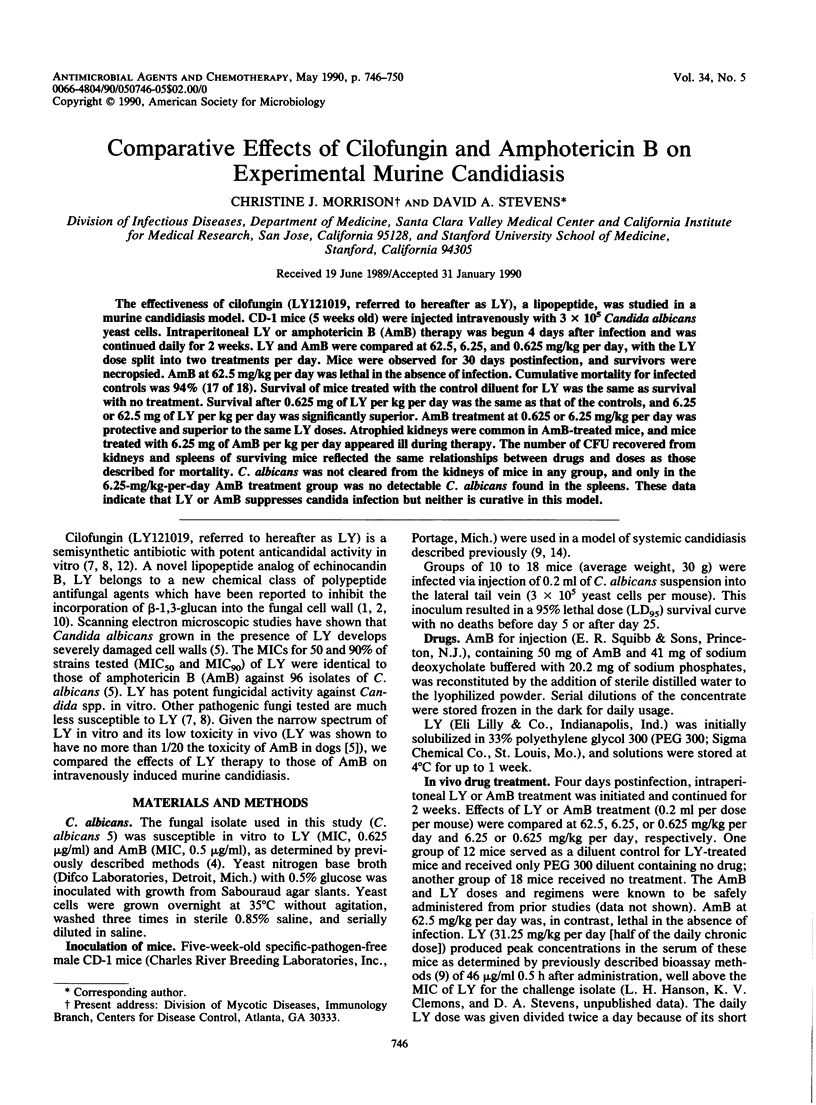
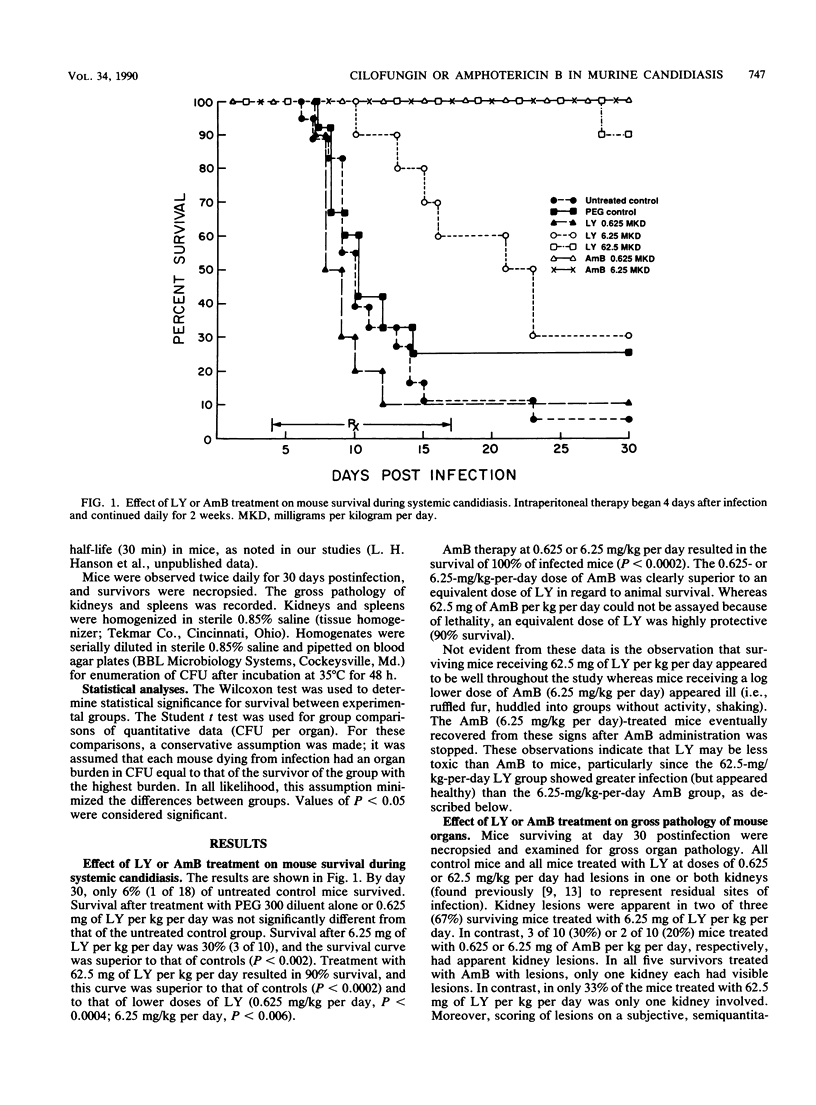
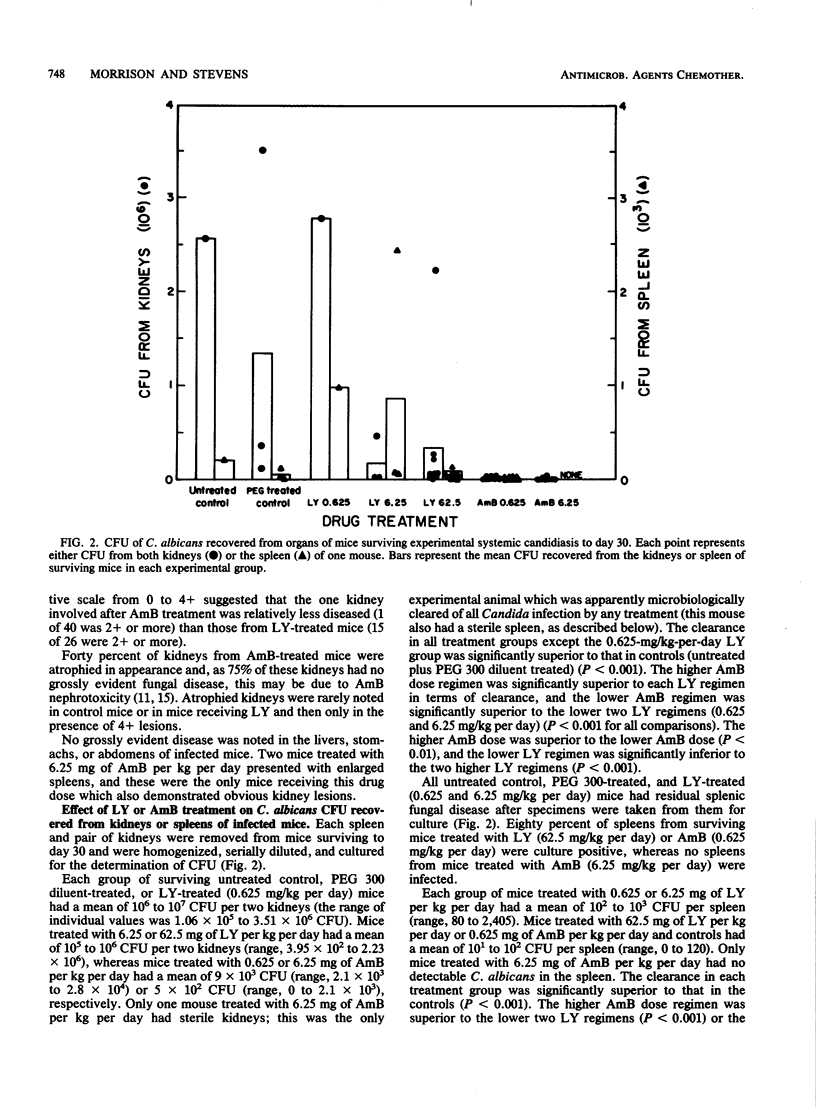
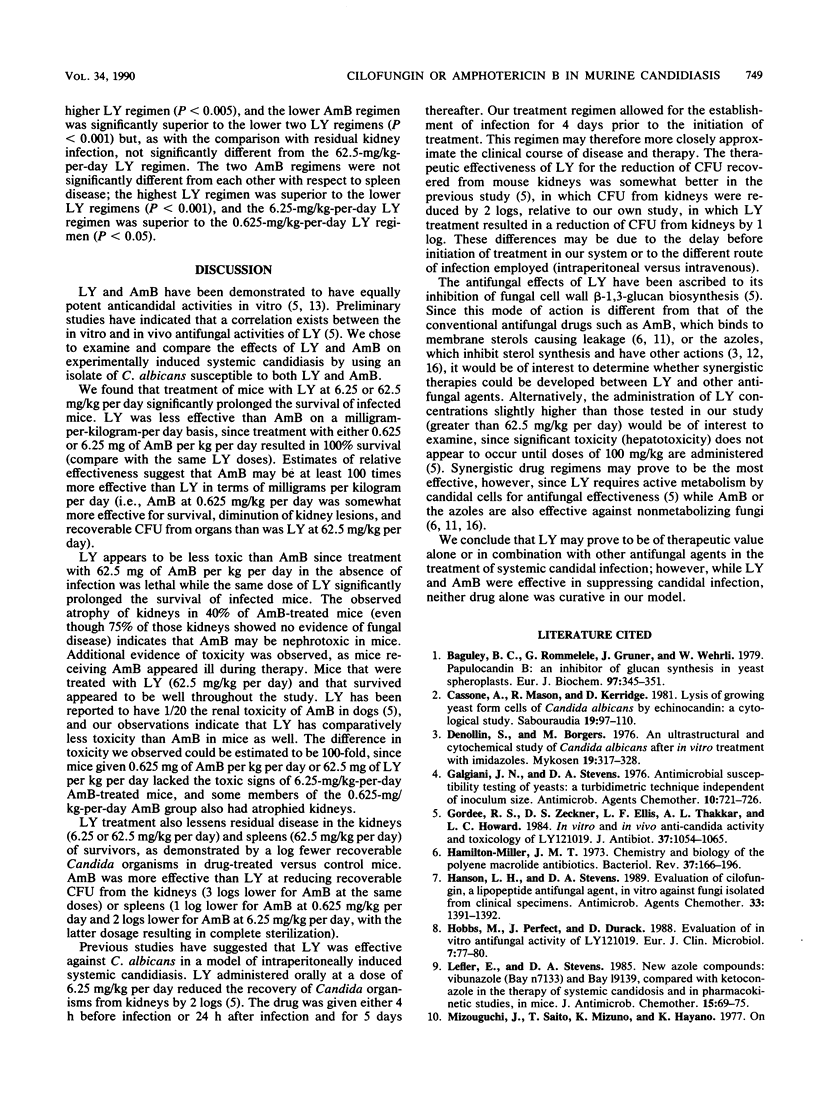
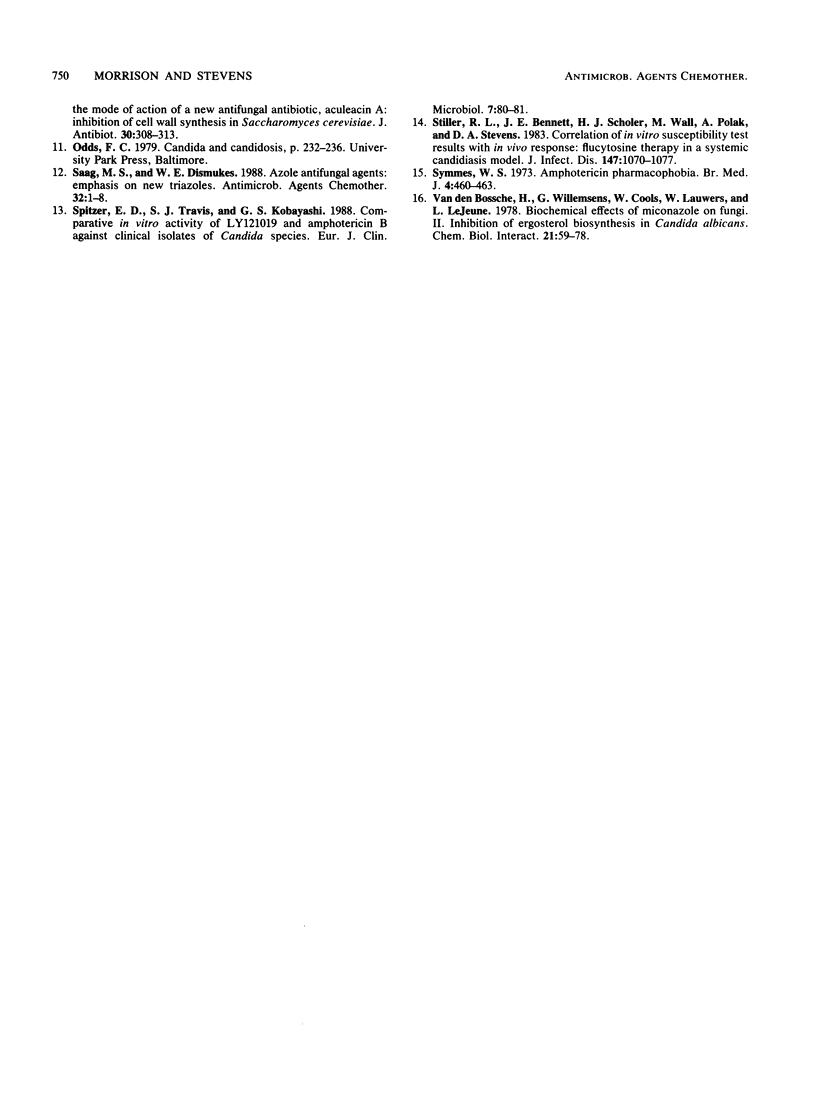
Selected References
These references are in PubMed. This may not be the complete list of references from this article.
- Baguley B. C., Römmele G., Gruner J., Wehrli W. Papulacandin B: an inhibitor of glucan synthesis in yeast spheroplasts. Eur J Biochem. 1979 Jul;97(2):345–351. doi: 10.1111/j.1432-1033.1979.tb13120.x. [DOI] [PubMed] [Google Scholar]
- Cassone A., Mason R. E., Kerridge D. Lysis of growing yeast-form cells of Candida albicans by echinocandin: a cytological study. Sabouraudia. 1981 Jun;19(2):97–110. [PubMed] [Google Scholar]
- De Nollin S., Borgers M. An ultrastructural and cytochemical study of Candida albicans after in vitro treatment with imidazoles. Mykosen. 1976 Sep;19(9):317–328. doi: 10.1111/j.1439-0507.1976.tb01469.x. [DOI] [PubMed] [Google Scholar]
- Galgiani J. N., Stevens D. A. Antimicrobial susceptibility testing of yeasts: a turbidimetric technique independent of inoculum size. Antimicrob Agents Chemother. 1976 Oct;10(4):721–728. doi: 10.1128/aac.10.4.721. [DOI] [PMC free article] [PubMed] [Google Scholar]
- Gordee R. S., Zeckner D. J., Ellis L. F., Thakkar A. L., Howard L. C. In vitro and in vivo anti-Candida activity and toxicology of LY121019. J Antibiot (Tokyo) 1984 Sep;37(9):1054–1065. doi: 10.7164/antibiotics.37.1054. [DOI] [PubMed] [Google Scholar]
- Hamilton-Miller J. M. Chemistry and biology of the polyene macrolide antibiotics. Bacteriol Rev. 1973 Jun;37(2):166–196. [PMC free article] [PubMed] [Google Scholar]
- Hanson L. H., Stevens D. A. Evaluation of cilofungin, a lipopeptide antifungal agent, in vitro against fungi isolated from clinical specimens. Antimicrob Agents Chemother. 1989 Aug;33(8):1391–1392. doi: 10.1128/aac.33.8.1391. [DOI] [PMC free article] [PubMed] [Google Scholar]
- Hobbs M., Perfect J., Durack D. Evaluation of in vitro antifungal activity of LY121019. Eur J Clin Microbiol Infect Dis. 1988 Feb;7(1):77–80. doi: 10.1007/BF01962182. [DOI] [PubMed] [Google Scholar]
- Lefler E., Stevens D. A. New azole compounds: vibunazole (Bay n7133) and Bay L9139, compared with ketoconazole in the therapy of systemic candidosis and in pharmacokinetic studies, in mice. J Antimicrob Chemother. 1985 Jan;15(1):69–75. doi: 10.1093/jac/15.1.69. [DOI] [PubMed] [Google Scholar]
- Saag M. S., Dismukes W. E. Azole antifungal agents: emphasis on new triazoles. Antimicrob Agents Chemother. 1988 Jan;32(1):1–8. doi: 10.1128/aac.32.1.1. [DOI] [PMC free article] [PubMed] [Google Scholar]
- Spitzer E. D., Travis S. J., Kobayashi G. S. Comparative in vitro activity of LY121019 and amphotericin B against clinical isolates of Candida species. Eur J Clin Microbiol Infect Dis. 1988 Feb;7(1):80–81. doi: 10.1007/BF01962183. [DOI] [PubMed] [Google Scholar]
- Stiller R. L., Bennett J. E., Scholer H. J., Wall M., Polak A., Stevens D. A. Correlation of in vitro susceptibility test results with in vivo response: flucytosine therapy in a systemic candidiasis model. J Infect Dis. 1983 Jun;147(6):1070–1077. doi: 10.1093/infdis/147.6.1070. [DOI] [PubMed] [Google Scholar]
- Symmers W. S. Amphotericin pharmacophobia. Br Med J. 1973 Nov 24;4(5890):460–463. doi: 10.1136/bmj.4.5890.460. [DOI] [PMC free article] [PubMed] [Google Scholar]
- van den Bossche H., Willemsens G., Cools W., Lauwers W. F., Le Jeune L. Biochemical effects of miconazole on fungi. II. Inhibition of ergosterol biosynthesis in Candida albicans. Chem Biol Interact. 1978 Apr;21(1):59–78. doi: 10.1016/0009-2797(78)90068-6. [DOI] [PubMed] [Google Scholar]


